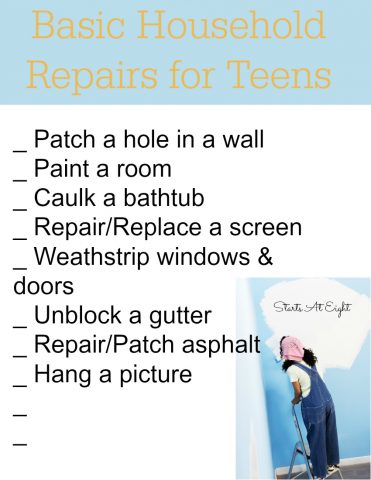Life Skills as High School Electives: Basic Household Repairs for Teens
This week our son was helping us spackle and sand our living room walls! This was made even more surprising to me by the fact that he ASKED to help us! Learning those skills, and others like painting a wall, working with a hammer and changing a light bulb are all important basic household repairs that teens should be learning. These types of skills will enable them to maintain a home and save money doing it.

Welcome to my series Life Skills as High School Electives: Home Economics and Shop Class. In this installment we are covering basic household repairs. You may find they already know how to do some of these tasks, so feel free to check those right off! Others you may not have covered yet, or even thought of! Be sure to grab my Life Skills as High School Electives: Basic Household Repairs for Teens printable list at the end of this post!
Basic Household Repairs for Teens
I grew up with a dad who pretty much did all the repairs and maintenance in our house. He was sort of a jack off all trades and the mastermind behind all our jerry-rigging and projects. Having grown up this way, I was surprised when I met my husband, and he couldn’t even swing a hammer. Throughout our early years of marriage we completely renovated a home, side by side with my dad. All the skills we both gained not only saved us a ton of money then, but have served us throughout the years and will continue to do so.
While we have our teens in our homes, we have a great opportunity to be able to have them work and learn alongside us. Learning to do the everyday (and not so everyday) tasks we do to maintain and repair the things in and around our home. So let’s get started!
1. Patch a Hole in a Wall
Walls can easily be damaged by screw and nails holes from hanging things. It can make the walls look run down and just plain hole filled. These can easily be repaired.
- Sand over the spot to flatten any rough spots out and wipe away any dust from sanding with a damp rag. Allow to dry.
- Place a small amount of drywall compound directly on the hole. Use a putty knife to smooth it flat.
- 3. Let it dry for a couple of hours.
- Sand the putty smooth with sandpaper. If there is still a hole or bump repeat putty application or sanding as needed.
Here is a tutorial for Patching Larger Holes in Walls
2. Paint a Room
Tools/Materials Needed:
- Drop cloths – You can use old sheets but remember that they paint can seep through the fabric. Plastic will keep any spilled paint from leaking through to the surface below.
- Painter’s Tape
- Small Rags
- Screwdriver
- Paintbrushes
- Sandpaper
- Paint tray and or small bucket – we like these little hand cups when doing brush work.
- Paint roller and roller heads
- Primer
- Paint
- Putty
First things first, you need to clear your space. Remove anything hanging on the walls. Either remove furniture completely or get it into the middle of the room. Then cover the floor and remaining furniture with drop cloths. Remove all switch plates and outlet covers. Then cover the sockets with painter’s tape.
Next you need to putty any holes (see #1 above)
If you are painting the ceiling and the walls, paint the ceiling first.
Prime first if needed. If painting new drywall, have done a lot of patchwork or are painting over a dark color you should use a primer paint first.
Do your edging first. Use a smaller angled brush and do all your edges. This means along the floor, ceiling, corners, around windows and outlets. We usually cover an area at least 2-3 inches out from each of these.
Complete the edges of only one wall area and make the switch to rollers. This will ensure your detail work is still we when you apply the first coat. Thus allowing you to blend and smooth the two together.
Prepare to roll. Fill a paint try with just enough paint that the top of the paint reaches the bottom of the ridged portion of the tray. Push the roller down into the paint then roll it over the grate to get they paint evenly spread around the roller. Paint the wall in large W shapes. Then go back over it with long, even vertical strokes to blend the paint on the wall.
Apply a second coat.
Once the ceiling and walls are painted, you can paint any door or window trim.
3. Caulk a Bathtub
4. Repair/Replace a Screen

Each of these are step by step instructions with photos of how to complete each one of these tasks.
How to Replace a Screen
How to Repair a Screen
5. Weatherstrip Windows & Doors
I love how the show you the heat loss via an infrared scanner in this video. Weather stripping windows and doors can make a huge difference in your heating and air conditioning costs, for a small amount of money put out to accomplish this task.
6. Unblock a Gutter
Having proper drainage off your house is so important. Having standing water around the base of your house can cause water to leak in to the basement of the house. If your house is nestled amidst trees that drop lots of needles or leaves it is a good idea to be proactive and install gutter guards.
But if you don’t have gutter guards you will need to clean out your gutters as part of yearly or even twice a year maintenance to keep them from backing up.
Tools:
- Rubber gloves
- Bucket
- Heavy trash bag
- Ladder
- Hand trowel or gutter cleaning tool
- Garden hose with sprayer
Start by detaching the downspouts. That way you can place a bucket directly underneath and nothing goes down causing more havoc in the downspout.
Scoop out the leaves and muck. With rubber gloves on either use your hands or a hand trowel/gutter cleaning scoop clean out all the large pieces, dumping into the bucket or heavy duty trash bag.
Hose out the small stuff. Once all the large stuff is gone, reattach the downspouts and use a garden hose to rinse down all the small stuff.
Clear the ground. Be sure the ground around the end of your downspout is clear. Keep grass cut down, remove any dirt piles, be sure the water can freely flow away from the exit of the downspout.
7. Repair/Patch Asphalt
This video talks about how to repair pot holes in your driveway. At the end it also covers cracks.
8. Hang a Picture
Before hanging anything you should measure the space and test your layout on the floor, using your largest or feature as the one you begin with.
Tools/Materials:
- Measuring tape
- Pencil
- Stud finder
- 4 ft. level
- Nails/screws
- Hooks/brackets/wire mounts
Check your placement. Before you bang any holes in the wall. Double check your placement on the wall. If something is heavy you may need to hang it in a stud and this would change where you could hang it. If you have anything over 50 lbs it will need a stud. If this is the case for you. Use the stud finder to locate a stud and then adjust your arrangement accordingly.
Measure and Mark. Using sticky notes for approximate placement can be really helpful as you fine tune your measurements. Place a sticky note at the top and approximate center of where you want to hang your pieces.
Measure from the ceiling down to the top of your picture. Then measure where the hanger location is on the back of your picture. For instance if you are hanging something 10 inches off the ceiling and the hanger is 3 inches from the top of the piece, then you would need to place your nail or screw at 13 inches from the ceiling for proper hanging height.
Leveling – If you have a piece that requires a hanger on each side. Measure for one side and then use a level set on top of the piece to level it before placing the second hanger.
*Note: We will often use a pencil to make marks on the wall, or trace corners of pieces for easier centering and leveling.
Printable List of Basic Household Repairs for Teens
I have created a printable list of these basic household repairs. You can print it and use it as a guide to check off as you teach your teen these skills. We have often found we just include them in the tasks we are doing around our home and thus they pick up the skills. When our oldest (then 13) wanted her room repainted, she did it with us. If there are things not on the list you would include, add them and talk about why you think they are important to have.
Another great way to enhance your record keeping is to take photos, print out any directions or tutorials you found useful and create a portfolio with the Printable Checklists and other items. I like using a 3 ring binder and creating tabs for each section of this Life Skills series. It will make a great reference for them later!
FREE Printable List
Click Basic Household Repairs for Teens Printable List to download the entire list in pdf format!

Life Skills as High School Electives: Home Economics & Shop Class Series
Be sure to book mark this page as this is the landing page for all of them!
Welcome to my series Life Skills as High School Electives: Home Economics and Shop Class. Over the coming weeks I will be talking about essential life skills and how to incorporate them into your high school transcript as high school electives. {Each topic will be linked here as they are completed.}
1. Home Economics
- Essentials for Stocking a Kitchen & Pantry
- Cooking Basics for Teens
- Sewing Basics for Teens
- Laundry & Clothing Tips
- house cleaning
2. Shop Class
- Essential Household Repair Tool Kit
- Basic Household Repairs for Teens {This Post}
- Basic Wood Working Projects
- plumbing and electrical
- mechanical






May 1, 2017 @ 9:05 am
Great list of ideas! Our problem is motivation and getting our son away from his cubes. 🙂
May 1, 2017 @ 1:42 pm
Our son likes his video games. Although despite playing them a ton, he is usually pretty good when we pull him away to do something else!
May 1, 2017 @ 2:40 pm
These are all great skills. I really needed that info on how to repair asphalt. I was just noticing a whole in the driveway. Maybe I can convince the teenager to do it. 🙂
May 1, 2017 @ 3:07 pm
Sounds like two birds with one stone to me! 🙂
May 1, 2017 @ 3:15 pm
These are some great skills for teens to have! Caulking the bath tub is one thing we’ve done recently, and it never occurred to me to pawn off the chore to one of my teen sons!
May 1, 2017 @ 4:00 pm
Yes! So many of these household repair/maintenance tasks have become things we include the kids in on. Plus once you teach them you can delegate, delegate, delegate!
May 1, 2017 @ 7:38 pm
Pinned and shared! This is great.
May 1, 2017 @ 8:15 pm
Thank you!
May 6, 2017 @ 10:04 am
What a fabulous list! My kiddos are still a bit young for these skills, but I think our 10 year can begin to slowly work through the Home Economics. You’ve saved us all a ton of time by putting these resources together. Thank you!
May 7, 2017 @ 9:58 am
Thank you Michelle! I am so glad this series can be of use to you and your family! I know how much having something put together can save time and energy!
March 20, 2022 @ 5:53 am
Hi, It was informative and had some great suggestions. Thanks for the post!